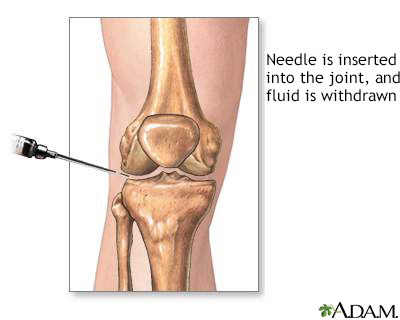Synovial fluid analysis
Definition
Synovial fluid analysis is a group of tests that examine joint (synovial) fluid. The tests help diagnose and treat joint-related problems.
Alternative Names
Joint fluid analysis; Joint fluid aspiration
How the Test is Performed
A sample of synovial fluid is needed for this test. Synovial fluid is normally a thick, straw-colored liquid found in small amounts in joints.
After the skin around the joint is cleaned, the health care provider inserts a sterile needle through the skin and into the joint space. Fluid is then drawn through the needle into a sterile syringe.
The fluid sample is sent to the laboratory. The laboratory technician:
- Checks the sample's color and how clear it is
- Places the sample under a microscope, counts the number of red and white blood cells, and looks for crystals (in the case of gout) or bacteria
- Measures glucose, proteins, uric acid, and lactate dehydrogenase (LDH)
- Measures the concentration of cells in the fluid
- Cultures the fluid to see if any bacteria grow
How to Prepare for the Test
Normally, no special preparation is needed. Tell your provider if you are taking a blood thinner, such as aspirin, warfarin (Coumadin), or clopidogrel (Plavix). These medicines can affect test results or your ability to take the test.
How the Test will Feel
Sometimes, the provider will first inject numbing medicine into the skin with a small needle, which will sting. A larger needle is then used to draw out the synovial fluid.
This test may also cause some discomfort if the tip of the needle touches bone. The procedure usually lasts less than 1 to 2 minutes. It may be longer if there is a large amount of fluid that needs to be removed.
Why the Test is Performed
The test can help diagnose the cause of pain, redness, or swelling in joints.
Sometimes, removing the fluid can also help relieve joint pain.
This test may be used when your doctor suspects:
- Bleeding in the joint after a joint injury
- Gout, other types of crystal disease, and arthritis
- Infection in a joint
What Abnormal Results Mean
Abnormal joint fluid may look cloudy or abnormally thick.
The following found in joint fluid can be a sign of a health problem:
- Blood -- injury in the joint or a body-wide bleeding problem
- Pus -- infection in the joint
- Too much joint fluid -- osteoarthritis or cartilage, ligament, or meniscus injury
Risks
Risks of this test include:
- Infection of the joint -- unusual, but more common with repeated aspirations
- Bleeding into the joint space
Considerations
Ice or cold packs may be applied to the joint for 24 to 36 hours after the test to reduce the swelling and joint pain. Depending on the exact problem, you can probably resume your normal activities after the procedure. Talk to your provider to determine what activity is most appropriate for you.
Gallery

References
El-Gabalawy HS, Tanner S. Synovial fluid analyses, synovial biopsy, and synovial pathology. In: Firestein GS, Budd RC, Gabriel SE, McInnes IB, O'Dell JR, eds. Firestein & Kelley's Textbook of Rheumatology. 11th ed. Philadelphia, PA: Elsevier; 2021:chap 56.
Pisetsky DS. Laboratory testing in the rheumatic diseases. In: Goldman L, Schafer AI, eds. Goldman-Cecil Medicine. 26th ed. Philadelphia, PA: Elsevier; 2020:chap 242.